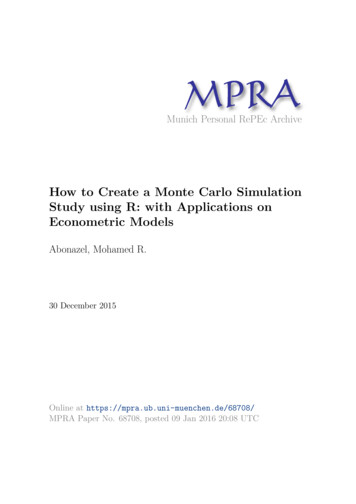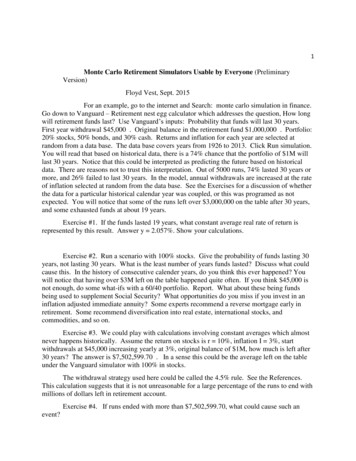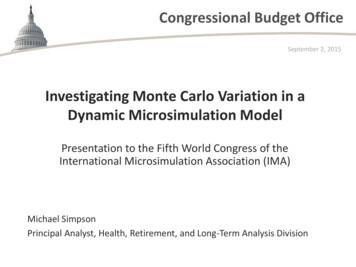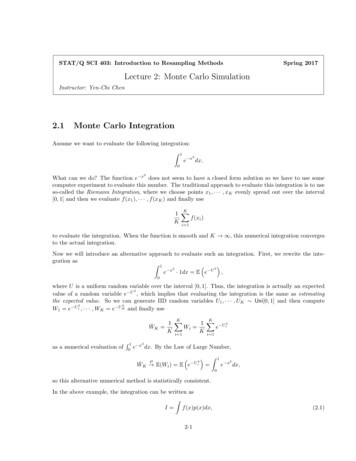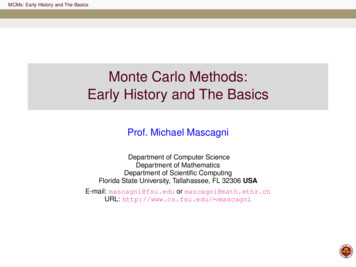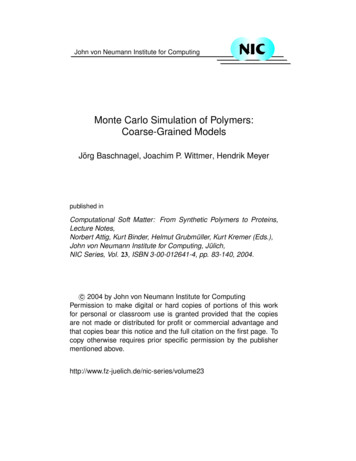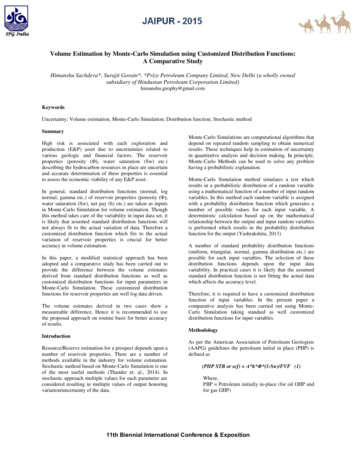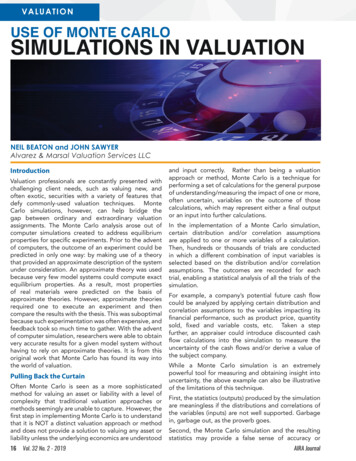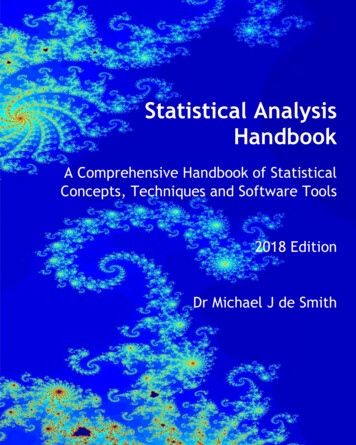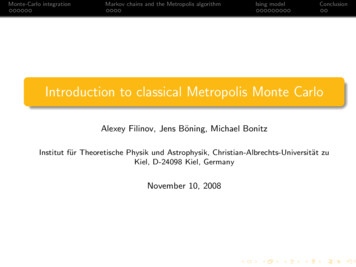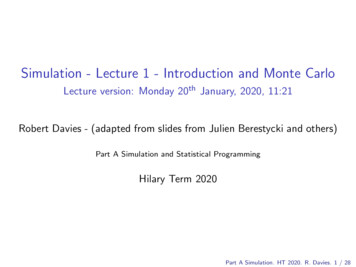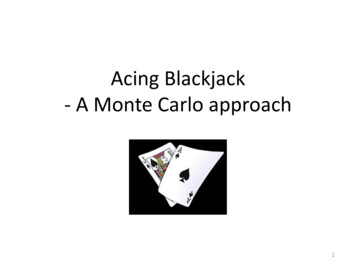
Transcription
Acing Blackjack- A Monte Carlo approach1
Blackjack 101 Blackjack (also known as 21) is the mostwidely played casino game in the world. It is a comparing card game played betweenplayer(s) and the dealer.– Players compete against the dealer but not againsteach other. The objective of the game is to outscore thedealer (via sum of dealt cards) withoutexceeding 21.2
Blackjack gameplay The player is dealt a two-card hand– Face cards (Kings, Queens, and Jacks) are counted as 10 points.– Aces may be counted as 1 or 11 points.– All other cards are counted as the numeric value shown on the card. The dealer then deals two cards from the deck for himself and shows onlythe first card (face-up) to the player. The second card is kept face-down. After looking at the dealer’s face-up card, the player may decide to "hit“,i.e., receiving additional card(s) one-by-one until The card sum crosses 21 (player is “busted”). Player decides to end his turn (player “sticks”). Once the player sticks, it becomes the dealer’s turn.– The dealer plays with a fixed strategy without choice: he continues tohit until his cards total 17 or more points. Finally, the player’s and dealer’s card sums are computed.3
Blackjack: ways to win Three ways to beat the dealer:– Get 21 points on the player's first two cards itself(called a natural), without a dealer natural. Thegame ends immediately in this case.– Reach a final score higher than the dealer withoutexceeding 21 (otherwise player busted).– Let the dealer draw additional cards until his handexceeds 21 (dealer busted). If the dealer and player hand sums are the same, it’sa tie!4
Blackjack 201 If the player holds an ace that he could count as 11 without goingbust, then the ace is said to be usable (also called “Soft Hand”).Otherwise, its called hard. The term soft means the hand has twopossible totals.– In this case it is always counted as 11 because counting it as 1would make the sum 11 or less, in which case there is nodecision to be made because, obviously, the player shouldalways hit. We only consider “Hit” and “Stick” here. Other options include– “Double Down” (double wager, take a single card and finish).– “Split” (if the two cards have the same value, separate them tomake two hands).– “Surrender”(give up a half-bet and retire from the game). Most blackjack tables have a payout of 3:2.5
Blackjack sample gameplayDEALERPLAYERPLAYER STICKS.12; NO USABLE ACEDEALER SUM 22;USABLEACEACEPLAYER SUM: 20;USABLE13; NODealer busted Player wins!6
The Problem What is the optimal winning strategy (policy)?i.e., When do you hit? When do you stick? Markov decision process provide a mathematicalframework for this environment:– The player and dealer cards constitute the current state.– The possible actions from any state are to hit or stick.– Transition probabilities represent the probabilities ofmoving to the next state.– At the end of game, the player gets a reward (win/loss). Finding the optimal state value or action value functiongives the solution to this problem.7
Dynamic Programing (DP) DP requires complete model of the environment as a Markovdecision process (states and possible actions/transitionprobabilities/expected immediate rewards). Optimal state-value function is DP methods require the distribution of next events which is noteasy to determine in the case of blackjack.– For example, suppose the player's sum is 18 and he chooses tostick. What is his expected reward and transition probabilities?These computations are often complex and error-prone.8
Monte Carlo (MC) Unlike DP methods, MC methods do not assumecomplete knowledge of the environment. MC methods require only experience--samplesequences of states, actions, and rewards from online or simulated interaction with an environment.– By trading-off exploration (in unknown territory)and exploitation (in known territory), MC methodscan achieve optimal performance.9
DP versus MCValue of a state depends on the averagereward, the transition probabilities andthe value of other statesValue of a state depends only on the finalreturn10
Advantages of MC over DP MC methods can be used to learn optimal behavior directly frominteraction with the environment, with no model of theenvironment's dynamics. Monte Carlo methods are particularly attractive when onerequires the values of only a subset of states.– One can generate many sample episodes starting from these states alone,averaging returns only from these states ignoring all others. MC methods do not “bootstrap”: The estimate for one statedoes not build upon the estimate of any other state, as is thecase in DP (or temporal difference learning methods). Not very sensitive to initial values; easy to understand and use. MC methods work in non-Markovian environments as well.11
Solving Blackjack Playing Blackjack is naturally formulated as an episodic finite MDP. Each game of blackjack isan “episode”.– We assume experience is divided into episodes, and that all episodes eventuallyterminate no matter what actions are selected.STATES & ACTIONSThe states depend on the player's cards and the dealer's showing card.Basically, the player makes decisions on the basis of three variables: his current sum (12-21),the dealer's one showing card (ace-10), and whether or not he holds a usable ace. This makesfor a total of (10*10*2 200) states.Possible actions from any state are hit and stick.RETURNSReturns of 1.5 , -1 , and 0 are given for winning, losing, and drawing, respectively only atthe end of the episode for every bet. Note: they are not the immediate expected rewards.All rewards within a game are zero, and we do not discount (γ 1); therefore these terminalrewards are also the returns.12
Monte Carlo control Finding the optimal policy (strategy) classicallycomprises a generalized form of policy iteration.– Start off with an arbitrary strategy π and evaluate itsstate/action values (Q).– Improve the strategy in a ‘greedy’ manner.– Repeat the policy evaluation and improvementsteps until the policy and action value functionsattain optimality.13
Monte Carlo with Exploring StartsAction valuesPolicyReturnsExploration phasePolicy evaluationGreedy policy improvementRecall: Q(s,a) represents the “action-value” function, and is the average rewardobtained upon starting at state s, taking action a and following policy π thereafter.Exploring starts assumes that episodes start with state-action pairs randomly selected.14
MC policy evaluationAn arbitrary policy*, πBlack: ‘HIT’White: ‘STICK’State values** (under the policy π)Black: ‘HIT’White: ‘STICK’Poor state values suggest that the policy is sub-optimal and could be improved.*A policy is a mapping from a state to an action.**State values represent the average reward (winnings) from any state.15
MC policy improvementsThe starting policy Π(t 0)Π (after 1e6 episodes)Π (after 5e5 episodes)Π* - The optimal policy(plotted after 5e6 episodes)STICKHITSTICKHIT16
The optimal value function17
Average winnings (for the optimal strategy) -0.425 with the payout of 3:2– If you play 100, you get back only 57 . Casinos typically use more than 1 deck todecrease these odds further– With 2 decks: -0.43– With 4 decks: -0.435– With 8 decks: -0.4418
Avoiding exploring starts Exploring starts can sometimes be arranged inapplications with simulated episodes, but areunlikely in learning from real experience. Instead,one of two general approaches can be used. In on-policy methods, the agent commits toalways exploring and tries to find the best policythat still explores. In off-policy methods, the agent also explores,but learns a deterministic optimal policy that maybe unrelated to the policy followed.19
Shortcomings of MC methods MC methods must wait until the end ofepisode before return is known.– Hence, they work for episodic (terminating)environments. High error variances. Problematic when the number of states is toolarge. Compared to temporal difference learning,convergence will be slow.20
What gives dealer the advantage? The house has an advantage in blackjack simplybecause the player has to draw first and if he busts, theplayer automatically loses regardless of whether thedealer would have busted or not. Player’s advantages over the dealer:– 3:2 winnings.– Double down, split, surrender options.– Dealer plays fixed strategy (stick at 17 or more). With the right strategy, house advantage can bereduced to -0.005, i.e., you lose 50 cents for every 100 bet (still negative!). Positive advantage if you can count cards ;)21
Advanced Blackjack Strategy22
The card sum crosses 21 player is busted _. Player decides to end his turn player sticks _. Once the player sticks, it becomes the dealer [s turn. -The dealer plays with a fixed strategy without choice: he continues to hit until his cards total 17 or more points. Finally, the player [s and dealer [s card sums are computed. 3
